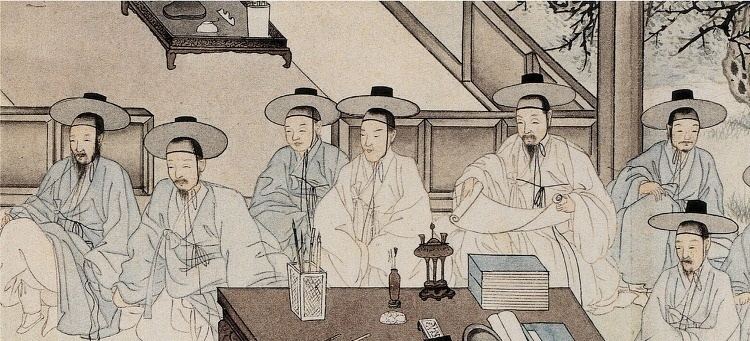 | ||
Korean ceramic history begins with the oldest earthenware from around 8000 BC.
Contents
History
Imaed Silla period (668–935) pottery was simple in colour, shape, and design. Celadon was subsequently the main production, with white porcelain or Baekja developing slowly in the 14th century, when the pace accelerated with new glazes, better clays, and variations of the white of different clays.
Simultaneously, the Buddhist traditions demanded celadon-glazed wares, and cheongja pieces of celadon porcelain with more organic shapes drawing on gourds, with animal and bird motifs that evolved very quickly. In some ways these were over-decorated wares, using exaggerated forms, stylized repeating designs and a wide variety of organic patterns. Cheongja wares used refined clays with a bit of iron powder added, then a glaze with a bit of added iron powder added once again, then fired. The glaze was durable with a slightly shinier and glossier finish, in an oily way, than whitewares.
Baekja wares came from highly refined white clay, glazed with feldspar, and fired in large regulated and clean kilns. Despite the refining process, white glazes invariably vary as a result of the properties of the clay itself; firing methods were not uniform, temperatures varied and glazes on pieces vary from pure white, in an almost snowy thickness, through milky white that shows the clay beneath deliberately in washed glaze, to light blue and light yellow patinas. After having succeeded the tradition of Goryeo baekja, soft white porcelain was produced in Joseon Dynasty, that carried on, but from the mid-Joseon on hard white porcelain became the mainstream porcelain.
The baekja wares reached their zenith immediately before the Joseon Dynasty came to power. Fine pieces have recently been found in the area around Wolchil Peak near Mount Kumgang. The transitional wares of white became expressions of the Joseon Dynasty celebrations of victory in many pieces decorated with Korean calligraphy. Traditionally white wares were used by both the scholarly Confucian class, the nobility and royalty on more formal occasions.
Goryeo Dynasty
The Goryeo Dynasty (918–1392) achieved the unification of the Later Three Kingdoms under King Taejo. The works of this period are considered to be the finest small-scale works of ceramics in Korean history.
Key-fret, foliate designs, geometric or scrolling flowerhead bands, elliptical panels, stylized fish,insects,birds and the use of incised designs began at this time. Glazes were usually various shades of celadon, with browned glazes to almost black glazes being used for stoneware and storage. Celadon glazes could be rendered almost transparent to show black and white inlays.
While the forms generally seen are broad-shouldered jars, larger low jars or shallow smaller jars, highly decorated celadon cosmetic boxes, and small slip-inlaid cups, the Buddhist potteries also produced melon-shaped vases, chrysanthemum cups often of spectacularly architectural design on stands with lotus motifs and lotus flower heads. In-curving rimmed alms bowls have also been discovered similar to Korean metalware. Wine cups often had a tall foot which rested on dish-shaped stands.
Joseon Dynasty
During the Joseon Dynasty, (1392–1897) ceramic wares were considered to represent the highest quality of achievement from royal, city, and provincial kilns, the last of which were export-driven wares. This was the golden age of Korean pottery, with a long period of growth in royal and provincial kilns, and much work of the highest quality still preserved.
Wares evolved along Chinese lines in terms of colour, shape, and technique. Celadon, white porcelain, and storage pottery were similar, but with certain variations in glazes, incision designs, florality, and weight. The Ming influence in blue and white wares using cobalt-blue glazes existed, but without the pthalo blue range, and the three-dimensional glassine colour depth of Ming Dynasty Chinese works.
Simplified designs emerged early on. Buddhist designs still prevailed in celadon wares: lotus flowers, and willow trees. The form most often seen was that of pear-shaped bottles. Notable were thinner glazes, and colourless glazes for buncheong or stoneware. Joseon White Porcelain representing Joseon ceramics was produced throughout the entire period of the Joseon dynasty. The plain and austere white porcelain suitably reflects the taste of Neo-Confucian scholars. Qing colouring, brighter and almost Scythian in enamel imitation, was rejected by Korean potters, in favour of simpler, less decorated wares in keeping with a new dynasty that built itself on Confucian doctrine.
Generally, the ceramics of this dynasty is divided into early, middle, and late periods, changing every two centuries, approximately; thus 1300 to 1500 is the early period, 1500 to 1700 the middle, and 1700 to 1900–1910 the late period.
The wares began to assume more traditional Korean glazes and more specific designs to meet regional needs. This is to be expected, as the Scythian art influences were of the former dynasty. The rise of white porcelain occurred as a result of Confucian influence and ideals, resulting in purer, less pretentious forms lacking artifice and complexity.
In 1592 during the Japanese invasion of Korea, entire villages of Korean potters were forcibly relocated to Japan, damaging the pottery industry as craftsmen had to relearn techniques because the masters were gone.
Exports
Nearly all exports of Korean ceramics went to Japan, and most were from provincial coastal kilns, especially in the Busan area. Export occurred in two ways: either through trading or through invasion and theft of pottery and the abduction to Japan of families of potters who made the wares. The voluntary immigration of potters was improbable since Joseon pottery was administrated by the Ministry of Knowledge Economy(工曹). As a national resource, pottery technician trade with foreign countries was prohibited.
Kilns
Central to Korean success were the chambered climbing kilns that were used throughout the Joseon dynasty and exported abroad, especially to Japan by Korean kiln-makers where they were renamed as noborigama in the Karatsu area from the 17th century on.
Modern kilns are either electric or gas-fired.
